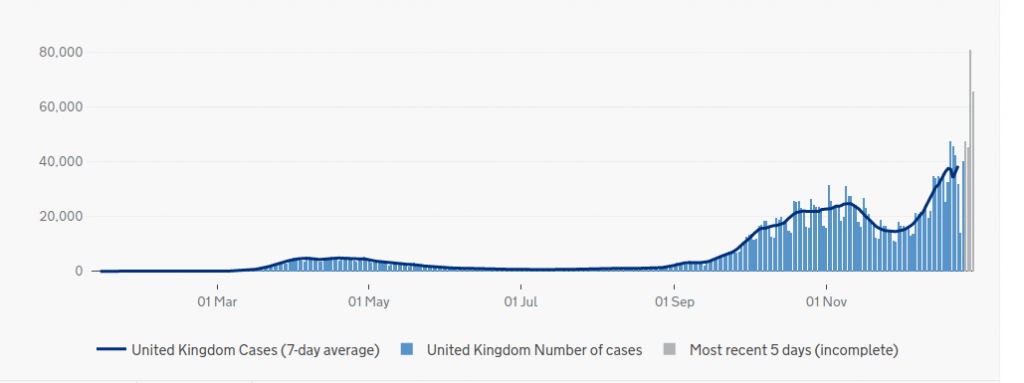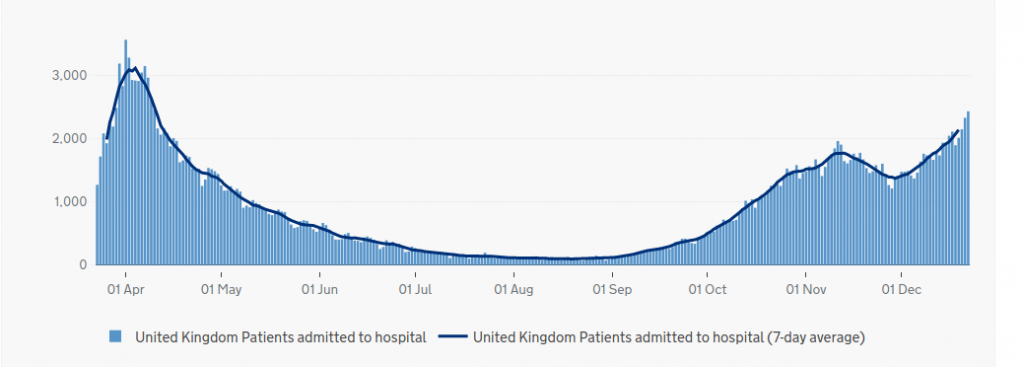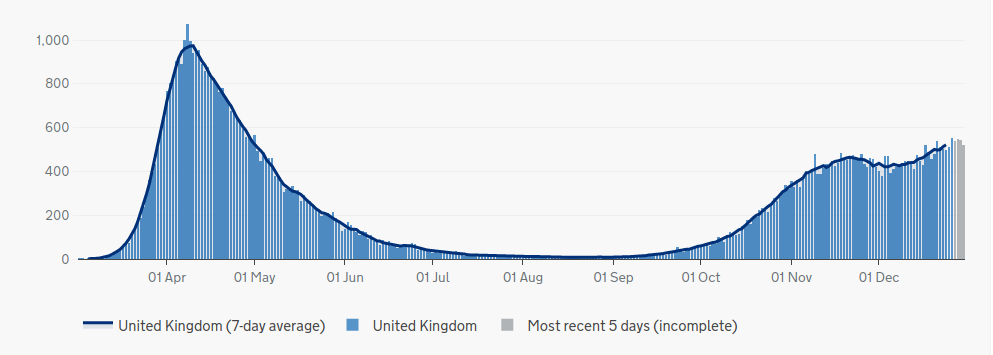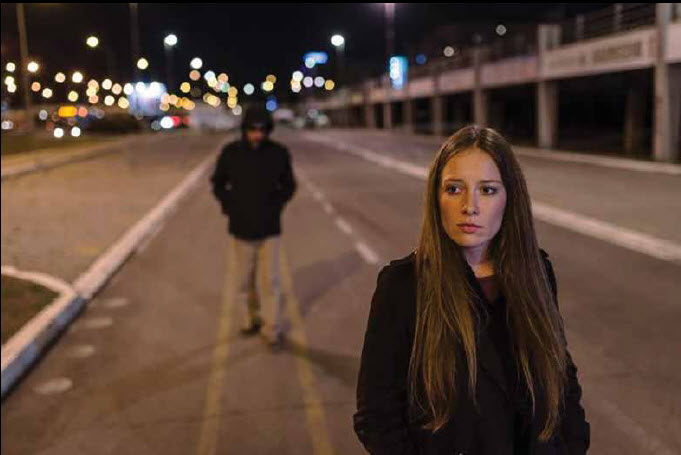Abstract
The imposition of a third national UK lockdown today presents a unique opportunity for gauging the effectiveness of lockdowns in managing the SARS-CoV-2 pandemic. It is unique because both the previous lockdowns began after deaths had already peaked, meaning that cases had reached their maximum perhaps 3 weeks before that.
Although the curves of both deaths and cases appeared to be unaffected by the additional effect of lockdown in either case, it is possible that they had some minor effect, as modelling by Imperial College has claimed for several countries, but not for Sweden, where in the absence of lockdown, interventions considered trivial elsewhere were concluded to be responsible for reversing the infections. The possibility that natural resolution occurred in all cases was not considered in that study, but is an important possibility.
At the onset of the present lockdown, though, cases, hospitalisations and deaths are all following a more or less linear increase according the latest reliable ONS statistics (24th December), as these ONS screenshots indicate (Figs. 1-3):



This overall pattern is what one would expect for early January in a bad influenza year, as the EuroMOMO data on excess deaths for the last few years shows (Fig. 4), though one should note that, there having been a run of fairly benign winter infection years recently, this chart shows spontaneous decrease in deaths early in early January in most years – a potential confounding factor for our study, unfortunately.

Be that as it may, the present data, combined with the knowledge gained about COVID-19 over the last year, makes it obvious that, if lockdowns are an effective policy, the sudden universal imposition of this one will necessarily produce a noticeable downward “kink” in the case-numbers (subject to the rate of testing remaining constant) in around 6 days from today (the average period from infection to positive PCR test), then a corresponding slowing of hospitalizations perhaps a week after that, and finally a reduction in deaths, or at least a noticeable slowing of increase (“flattening the curve”), around 3 weeks from today.
The last effect, it should be said, may be more difficult to detect, as the increase in deaths is so low already, and not clearly related in degree or natural timing to the other two measures.
Nevertheless, the observation of these effects, or their absence, will give a good indication, in a short time from now, of whether lockdown has had the effects desired and predicted by its advocates. If the effect of lockdowns is negligible (the null hypothesis), as many studies across the world have indicated this year, no such clear change will be seen. These are testable predictions.
Should this lack of effect be observed, experience shows that critics may blame non-compliance by the public rather than the policy itself. This, however, would be misguided: lockdown, with all its associated legal penalties and the extensive use of behavioural psychology (which the WHO has lauded as one of the great gains from this pandemic for future policy), is a practical policy, not a theoretical one. By analogy, one would not criticise laws against fraud on the basis that people still commit it: good laws deal with society as it is, and not as it ought to be: “Politics is the art of the possible” (Bismarck).
Furthermore, such indications of the failure of lockdown overall would also demonstrate that the individual componensts within it, additional to measures already in place in each of the tiers (such as closure of schools, limitations on movement or association and so on) are equally ineffective. Within the next month, then, or even within the next week based on case numbers, it should be possible to determine conclusively the effectiveness, or otherwise, of lockdowns. This time-course is short enough to exclude the possible benefits of mass-vaccination as a confounding effect, which is not yet sufficient to affect the outcomes substantially, but may well confuse the issue if both lockdowns and vaccination are continued into the spring, when in any case seasonal excess deaths would be expected to fall dramatically.
If this lockdown proves not to change the course of cases, hospitalisations and deaths measurably, according to the known natural history of the disease under study, then no doubt SAGE and NERVTAG will have solid grounds for advising the government to abandon such measures immediately, and for the future. Lockdowns will have proved to be an unprecedented and hugely costly experiment that has, regrettably, failed. We are pleased to remember that our government’s mantra throughout this pandemic has been “Follow the Science,” so we may expect this laudable policy to continue in the light of our study.


Boris claims that 1 in 50 now have COVID: but the latest daily death figures are 570. So if he’s right, then the Infection Fatality Rate has dropped to only only about 0.04% from 2.4%! The bug is losing its mojo.
An alternative, of course, is that Johnson is talking out of the back of his head again. If 1 in 50 of us do have it, lockdown seems a futile gesture as we’ll all test positive by the end of the week!
Another clue: this Daily Mail article reveals that a graph shown in HMG’s last presentation shows that London and the Southeast had already turned the corner on cases and began to drop by 24th December (the chart included is too vague to date accurately, but careful work with a ruler shows it was that date). No doubt this information was known already when national Tier 5 lockdown was imposed.
Since Tier 4 was introduced on 19th Dec that might mean that the difference between Tiers 3 and 4 is definitive, but 5 days is really too short, when there is known to be a high false negative rate up to the optimum 8 days for PCR testing (according to Johns Hopkins research). That’s why hitherto we have been told not to expect the effects of lockdown to be seen for a fortnight (not five days).
The effectiveness of Tier 4 is the spin being put on it by government, anyway. In which case, why submit the whole country to a new, harsher, Tier 5? But wait – London only went into Tier 3 on 14th December, just 10 days before the cases started to drop, so maybe Tier 3 was enough to beat the new strain of COVID. Yet in Liverpool, earlier in the winter, cases started to drop under Tier 2. With all the musical chairs, who could ever tell what has worked, and what has not?
Or alternatively, the improvement might be nothing whatsoever to do with tiers. It may mean that the usual kind of seasonal reversal in early January mentioned in my OP has already begun in London and the southeast, and (cynically) that it has been used by government to prove that lockdown works, once the same pattern spreads to the rest of the country, as it surely would.
Once more, the narrative of lockdown effectiveness flies in the face of the actual data, when closely examined.
In other news, the WHO says that Britain’s decision to give 2nd vaccine doses late is not recommended. And they’ve already said that lockdowns should not be used routinely by governments because of their dreadful costs. So on some things, we know better than the WHO, whereas other policies such as mask-mandates and PCR diagnoses are essential because the WHO says so. Make sense to you?
Tell me I’m in a nightmare, not the real world! Remember what killed most of the victims in Sweden? In New York? In Britain? That big lesson we learned early on about how not to manage COVID?
Today on the BBC World at One a government spokesman said that, to ease the pressure on hospitals, they’re going to send patients into care homes to be looked after. Of course, they won’t be COVID patients – until they develop their infections on arrival and wipe out another cohort of people they’ve kept in prison for a year for their own protection.
I see there is a good post on Lockdown Sceptics making much the same predictions as my OP, with some additional data, some actual calculations of how likely the government are to “fluke out” and see the lockdown apparently working… and most significant of all, the prediction that when it doesn’t work, the government will get angry, blame us, and screw things down (and up) further. That horse has stopped twitching – hit it harder.
With the last conclusion I completely concur. There is simply no room in their, or the public mind, to admit that the whole lockdown idea (invented this March by politicians in Communist China) is ineffective, despite the numerous studies that have proved it. If they add some extra measures every fortnight, at some stage the season will end and they’ll take the credit from the curfew, compulsory bloodletting or whatever was the most recent wheeze.
Stupid lockdown news for the day:
(1) Positive cases are still going up, so Something Else Must Be Done.
Well, lockdown is less than a week old, so why would anything have changed yet, it taking at least 6 days for “cases to test positive? In any case, numbers continue to drop in the areas that started improving around Christmas.
And as ever, sampling size has not even been considered, though testing has continued to increase. In fact positive test percentage for the week ending today is 12% – 1% DOWN on last Monday when I wrote the OP.
(2) What we must do now is close the nurseries and churches!
I can’t speak for nurseries, apart from their vital nature to many working mothers. And that small children are neither at risk from, not recorded as spreading, COVID.
But consider this: Tier 5 took effect last Monday, and the calls for church closures are clamouring in the Sunday morning news. So tell me just how many church services there have been during that period to account for the ongoing spread nationally? Answer, of course, is zero (apart from the 7th Day Adventists). But any scapegoats will do rather than admit the obvious fact that – pending my look at the data during this next week – lockdowns just don’t do anything for COVID whatsoever.
Sunday Mail today: “The Health Secretary refused to speculate when directly asked if measures like curfews, limits to time allows outside homes and making masks compulsory outdoors might be brought in.”
Now, Hancock knows lockdowns are a successful policy, because at the worst peak of the pandemic in March, no sooner was lockdown imposed but things rapidly began to get better. All without curfews, 1 hour limits to exercise or masks outdoors or even indoors, come to that.
Hancock at present prefers the “lazy prisoners” explanation, but since he can hardly enforce the current lockdown more fiercely without declaring martial law, no doubt all these other rituals will be initiated once lockdown fails, at SAGE’s scientific behest, to appease the virus.
But what has suddenly happened to the science to make a virus that capitulated at the first trumpet blast in March suddenly resist so much more now? No doubt the “new strain” will be accorded these magical powers to travel miles through open countryside unless humans are muzzled on their hour in the exercise yard and kept in at night.
But that beggars belief. How about the simpler explanation: LOCKDOWNS HAVE NEVER MADE A DIFFERENCE AND NEVER WILL.